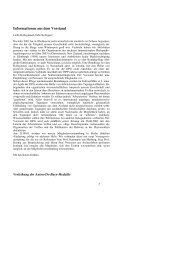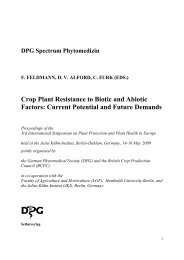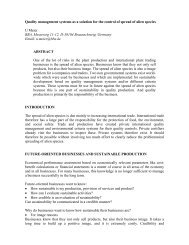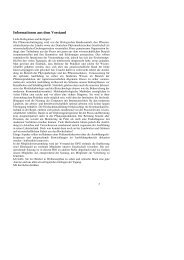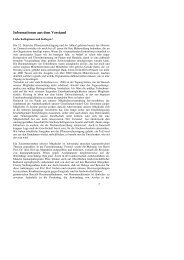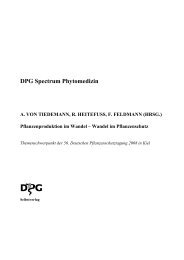PHYTO MEDIZIN Mitteilungen der Deutschen ... - Die DPG
PHYTO MEDIZIN Mitteilungen der Deutschen ... - Die DPG
PHYTO MEDIZIN Mitteilungen der Deutschen ... - Die DPG
Erfolgreiche ePaper selbst erstellen
Machen Sie aus Ihren PDF Publikationen ein blätterbares Flipbook mit unserer einzigartigen Google optimierten e-Paper Software.
twodimensional gel electrophoresis in combination with hybridization and<br />
electron microscopy we have discovered that the recombinational flexibility<br />
is reasoned by a recombination-dependent replication mode (RDR) that is<br />
widespread at least among begomoviruses and curtoviruses but does also<br />
occur for satellites, beta DNAs and artificial episomes. Compared to complementary<br />
strand synthesis (CSR) and rolling circle replication (RCR),<br />
which both were found together with RDR, the latter mechanism allows the<br />
virus to repair every broken or unfinished DNA intermediate as far as homologous<br />
templates are available. Using virus-specific two colour detection,<br />
we found out the the frequency by which different geminiviruses enter the<br />
same nucleus was surprisingly high in tomatoes and N. benthamiana, so that<br />
the chance to recombine two viruses is extremely high. Moreover, weeds are<br />
ideal cradles for new geminiviruses since they are reservoirs and collect several<br />
virus species over years, as exemplified for Sida micrantha-associated<br />
geminiviruses. Surveying different combinations of geminiviral and satellite<br />
DNAs two strategies can be discriminated between Old World and New<br />
World begomoviruses. The first were rather promicous to transreplicate other<br />
DNAs, even without a cognate Rep-binding sequence, whereas the latter need<br />
the interaction of Rep and Rep-binding sequences and consequently DNAs B<br />
were acquired by shuffling of the regulatory region (common region CR) by<br />
homologous recombination. The consequences of these findings for efficient<br />
resistance breeding and epidemiology will be discussed.<br />
BNYVV-like particles formed by coat protein expressed from a potexvirus-based<br />
vector construct<br />
R Koenig, S Loss and D-E Lesemann; c/o Biologische Bundesanstalt, Institut für<br />
Pflanzenvirologie, Mikrobiologie und biologische Sicherheit, Braunschweig<br />
We have recently determined the nucleotide (nt) sequences of the genomic<br />
RNAs of three potexviruses which had been isolated long ago from different<br />
species in the Cactaceae and were originally designated as different strains,<br />
i.e. BS, CC10 and K11, of Cactus virus X. Because serological and molecular<br />
studies revealed only rather distant relationships between these viruses, we<br />
have proposed to change their taxonomic status and rename them to Zygocactus<br />
virus X (ZVX), Opuntia virus X (OVX) and Schlumbergera virus X<br />
(ScVX), respectively. The full length cDNA sequence of ZVX RNA was<br />
cloned into the 35S promoter-containing vector p35Stupa kindly provided by<br />
E. Maiß, Hannover. The cDNA clones obtained consistently produced symptomless<br />
local and occasionally also systemic infections in C. quinoa. In or<strong>der</strong><br />
to enable insertion and expression of foreign genes an AscI and a SpeI site<br />
10




